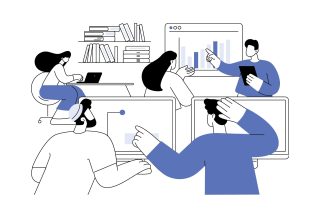IDEAS
30 seconds of video reinforces teachers’ strengths
By Joan Richardson
Categories: Coaching, Continuous improvement, TechnologyDecember 2023
Thirty seconds. That’s often enough video of their own instruction for teachers to learn about something they are doing right — and, importantly, to identify an effective practice that they could repeat more often.
The power of using a brief video clip during one-on-one coaching conversations is that teachers experience intense personal attention about the work that matters to them the most. That emerged as the most influential component of the MyTeachingPartner-Secondary (MTP-S) program, a model built on decades of research about effective coaching, according to recent interviews and focus groups.
Learning Forward conducted those interviews and focus groups as part of a project to extend the MyTeachingPartner model, which has been successfully used in elementary and preschool settings (Hamre & Pianta, 2005; Allen et al., 2011) to secondary schools across a range of states and school types.
What can a teacher learn in 30 seconds
in 30 seconds  ? A great deal, it turns out. Brief video clips in the MyTeachingPartner-Secondary (MTP-S) program reveal what teachers are doing right–and what they can repeat more often. @AIRInforms… Share on X
? A great deal, it turns out. Brief video clips in the MyTeachingPartner-Secondary (MTP-S) program reveal what teachers are doing right–and what they can repeat more often. @AIRInforms… Share on X
“It was my clip. It was my time. I felt like I was the only one that (the coach) was talking to,” said one Michigan teacher. A Texas coach observed that “what we plan to do and what we actually do is very different, and exposure to that reality is very eye-opening. (Teachers) watching themselves teach was more eye-opening than anything I would say.”
Other elements of MTP-S resonated with participants as well. Teachers valued the model’s emphasis on seeking their strengths rather than focusing on their deficits. They also applauded the model for how its predictable structure defined expectations for the process.
For five years, Learning Forward engaged in a partnership with the American Institutes for Research and Teachstone to learn more about how the MTP coaching model could be scaled, especially in secondary schools. The project was funded by a 2017 grant from the U.S. Department of Education through its Education Innovation and Research Program.
Learning Forward’s interest in MTP comes from its longstanding belief in the value of coaching as an integral part of a comprehensive professional learning program because of coaches’ ability to provide day-to-day support for educator growth and learning. The MTP-S model aligns in many ways with the Standards for Professional Learning (Learning Forward, 2022), which provide guidance to educators on acquiring new knowledge and applying new learning to improve practice and sustain changes that lead to student learning.
Two recent randomized control trials studies found that MTP-S has positive impacts on student achievement: One found positive impacts on middle and high school student achievement and engagement in small and rural districts (Allen et al., 2011; Gregory et al., 2014), and another in urban middle and high schools found not only improvement in student achievement, but also a reduction in racial discrepancies in exclusionary disciplinary practices (Allen et al., 2015; Gregory et al., 2016).
Follow-up revealed that, even after the project ended, teachers who had participated in the coaching intervention maintained lower disciplinary referral rates and consistency of referrals by race (Gregory et al., 2016).
How MTP-S works
Several components of the MTP-S model set it apart from other coaching approaches. Using video as the centerpiece of the coaching experience is the first component. The second is MTP-S’s focus on teacher strengths, which means that coaches search for what teachers are already doing well in their interactions with students to replicate and build on those existing assets. The third component is the set of structured steps that MTP-S follows for each coaching cycle.
MTP-S coaches must be certified by Teachstone, the company that supports and disseminates the model to schools. Coaches learn how to use the Classroom Assessment Scoring System (CLASS), a research-based rubric that has been rigorously tested and validated, which focuses on interactions between teachers and students and peer interactions in three domains: emotional support, classroom organization, and instructional support.
Research has shown that teachers’ ratings on these dimensions are strong predictors of students’ academic and social success (Hamre et al., 2013). A focus on student engagement provides a through line among all the domains.
Once paired, coaches introduce the teachers to the CLASS domains, dimensions within those domains (such as teacher sensitivity and quality of feedback), and observational indicators and behavioral markers within each of those dimensions (such as teacher questioning or noticing and the use of real-world examples). Before each coaching cycle, the coach and teacher agree on which aspect of classroom interaction will be the focus of the upcoming cycle.
After that, coaching follows a predictable pattern of five steps. In most cases, a cycle takes two weeks to complete. The steps of the cycle are:
- To begin the coaching cycle, teachers digitally record 30 minutes of their own instruction and upload this footage to a secure platform accessible to their coach. Teachers select the lesson to record and when to do the recording. (Before they sign on with an MTP-S coach, teachers know that recording their instruction is required.)
- The coach watches the entire video and selects three short clips — 30 seconds to two minutes long — that show a specific strategy or move by the teacher that created an effective interaction that encouraged student engagement.
- The coach writes a reflection email guided by prompts (developed by Teachstone) for the teachers to consider before their next coaching session.
- The coach and teacher conference together for about 30 minutes to review the clips and the teacher’s reflection on the clips and discuss how to strengthen or expand on that effective practice in the next cycle. Coaching can be provided virtually or face to face, depending on the district’s plan.
- The coach writes a summary, including an action plan for what CLASS dimension and indicators will be addressed next.
The cycle then repeats, so that teachers can see their actions and their students’ reactions in an analytical way and have an opportunity to pause and reflect on practices that work. This makes it more likely that the teacher will repeat the effective practice — an explicit purpose of the cycles and the coaching.
The value of video
The video clips gave teachers a rare opportunity to step back and see themselves in action, something that few of the participants in the MTP-S project had experienced. The videos allowed teachers to home in on moments and interactions that may have seemed small but were actually significant. Some of those moments revealed practices teachers wanted to do more of, and some less.
Several teachers, for example, reflected on the CLASS indicators related to positive climate and teacher sensitivity and recognized that they were often pointing at students rather than calling on them by name to respond to a question. “I was surprised to learn that I wasn’t already doing that,” one Wyoming teacher said of using students’ names. “When I changed and started doing that and when I encouraged students to use each other’s names, that brought even more respect into the classroom,” she said.
Other teachers became more sensitive to how they were facilitating the CLASS dimension of instructional dialogue, recognizing how often their voices dominated the classrooms and how often their perspectives took precedence. One social studies teacher observed this during a video clip: “I make connections to the real world all the time, but are they my connections or are they adolescent connections? I started allowing kids to share their examples before I share mine. An adolescent perspective is different. Real world can mean so many different things to different people,” she said.
Video is a powerful component and can also be used outside of the MTP-S program. Sharron Helmke, Learning Forward’s senior vice president for professional services content, said, “Most experts on coaching believe that the fastest way to get teachers to change is through video. Teachers can’t argue with what they see on video.”
Looking for the good
Although teachers sometimes identified practices they wanted to change, many also recognized what they are already doing well and reflected on how to build on that. MTP-S uses the video clips to intentionally focus on identifying a teacher’s strengths. As one coach noted, “Everybody does something right.” This expectation to look for the strengths builds a teacher’s sense of efficacy and offers each teacher a path for taking the next step in improvement.
One teacher expressed frustration that she often had to repeat a direction for her students. What the coach saw, however, was a teacher being very firm and very calm, going over something as long as necessary until it sank in with students. “You’re not questioning your decision, and that’s a positive,” said the coach.
Another teacher had a well-developed routine that opened her class every day. The coach was able to point out this strength to her and encourage her to build on it in other aspects of her instruction. “It was so well done that students were doing it without being prompted. That did not just happen overnight. At some point, she had to teach them that routine,” said the coach. The coach encouraged her to recognize this as a strength and pushed her to identify where she could introduce a similar routine in another part of her instruction. “That was a very powerful moment of learning for her,” said the coach.
The asset focus has other benefits, too. It helps encourage teacher participation and buy-in to the program by overcoming the oft-held belief that coaching is only about fixing a teacher’s problems. And the connection between coach-teacher conversations and teacher-student conversations is clear. As one principal said, “If we (focus on strengths) with teachers, then they will do that with the kids.”
Several experienced coaches who participated in the project noted that explicitly focusing on strengths was a change in focus for them and something that could work with any coaching model. “It was a mindset shift for us,” said one experienced coach in Michigan. “We weren’t there to fix something.”
Another experienced Michigan coach said of her and her colleague’s prior coaching practices, “Neither of us ever went in and just ripped someone apart, but I don’t think we ever deliberately focused on the strengths, just totally building on all of the assets to get all the way stronger.”
This emphasis on teachers’ strengths within teacher-student interactions is not intended to be the sole solution for improving instruction. But a focus on improving the teacher-student relationship is one approach to building teachers’ supports for all students. As Learning Forward’s CEO Frederick Brown pointed out, “The teacher video is capturing a slice of what’s going on in the room.” That slice doesn’t give the coach the full view of what’s happening in the classroom, but it does give them a place to start building up the dimensions of teacher-student interactions that research shows are important.
Structure matters
The consistency of MTP-S’s prescribed coaching cycle benefits schools and districts that operate on strict schedules and must meet competing demands from many sources. The structure also helps everyone be accountable. Teachers know when they have to record the lesson. Coaches know how many days they have to provide feedback. The teacher and the coach both know when they will be sitting down for the coaching conversation and how long it will last.
Specifying that teacher and coach will meet for only 30 minutes, for example, makes the meeting more palatable to teachers because they know they will not lose an entire planning period. That structure also helps establish coaching in a teacher’s routine.
Participants found the transparency and structure of the coaching cycle to be liberating. Teachers and coaches knew what would happen during each segment, which helped them relax about what was coming next and helped develop trust between teacher and coach.
The brevity of the video clip ensured that teachers and coaches zeroed in on just one interaction or strategy, which kept the conversation focused and prevented it from rambling into too many directions to be effective. A coach in Wyoming said that previous coaching experiences had felt like “drive-by coaching,” compared with the more structured MTP-S coaching model. “Somebody would stop by, do a little observation, give you a little sticky note feedback on whatever was happening in the classroom when they came by. The very structured (MTP-S) cycles takes a lot of guesswork out of deciding where to go next, but there’s still a lot of flexibility. The structure freed up teachers to focus on just what was happening.”
The MTP-S coaching is also job-embedded and timely. A Virginia coach noted, “I love the framework of the cycles. Because it was so focused on them (the teachers) and what they needed in those two weeks, it was pretty perfect professional development. It’s so structured. It’s not free-flowing. Teachers were steering the ship. They were talking about where they wanted to go next.”
Making coaching accessible
Coaching is a powerful model for professional learning that Learning Forward has advocated and supported for decades. And the MTP-S model could make coaching more accessible. For example, the option to employ virtual coaches could enable more districts, especially poorly resourced rural districts, to add coaching to their portfolio.
Experts say it is important to remember, though, that coaching is not a magic solution to all of a school’s challenges. Learning Forward’s chief learning officer Paul Fleming, who has been a high school principal, says, “Coaching works best in places where they’ve done a lot of work. It thrives in a school culture where there already is collaboration and respect for collaboration.”
Fleming said principals could learn a great deal from MTP-S’s focus on teachers’ assets. “Principals often look at teachers through an evaluation lens and not through a continuing growth approach. One of the powers of this model is recognizing teachers’ assets and holding up a mirror to enable teachers to see them.”
Download pdf here.
''Most experts on coaching believe that the fastest way to get teachers to change is through video. Teachers can’t argue with what they see on video.'' For this and more MTP-S insights
 https://bit.ly/48IQCI2 #coaching… Share on X
https://bit.ly/48IQCI2 #coaching… Share on X
MTP-S model supports Standards for Professional Learning
The MTP-S model supports the Standards for Professional Learning by focusing on improving student learning through improving teacher practice in a comprehensive way. It recognizes the power of job-embedded and sustained professional learning. Of note are three of the 11 standards:
- Culture of Collaborative Inquiry, which expects that educators in every role, grade level, and content area will collaborate for continuous improvement and support their colleagues’ ongoing learning and development;
- Equity Foundations, which makes explicit that ensuring equity and improving student learning requires a culture of support for all staff. Promoting the growth of all educators lays a foundation for promoting the growth of all students; and
- Implementation, which values a culture that regularly engages in meaningful, constructive feedback and aids educators to apply new learning to improve their practice and sustain those changes over time.
References
Allen, J.P., Hafen, C.A., Gregory, A., Mikami, A., & Pianta, R.C. (2015). Enhancing secondary school instruction and student achievement: Replication and extension of the My Teaching Partner-Secondary Intervention. Journal of Research on Educational Effectiveness, 8(4), 475-489.
Allen, J.P., Pianta, R.C., Gregory, A., Mikami, A.Y., & Lun, J. (2011). An interaction-based approach to enhancing secondary school instruction and student achievement. Science, 333(6045), 1034-1037.
Gregory, A., Allen, J.P., Mikami, A.Y., Hafen, C.A., & Pianta, R.C. (2014). Effects of a professional development program on behavioral engagement of students in middle and high school. Psychology in the Schools, 51(2), 143-163.
Gregory, A., Hafen, C.A., Ruzek, E.A., Mikami, A.Y, Allen, J.P., & Pianta, R.C. (2016). Closing the racial discipline gap in classrooms by changing teacher practice. School Psychology Review, 45(2), 171-191.
Hamre, B.K. & Pianta, R.C. (2005). Can instructional and emotional support in the first-grade classroom make a difference for children at risk of school failure? Child Development, 76, 949-967. dx.doi.org/10.1111/j.1467-8624.2005.00889.x
Hamre, B.K., Pianta, R.C., Downer, J.T., DeCoster, J., Mashburn, A.J., Jones, S.M., Brown, J.L., Cappella, E., Atkins, M., Rivers, S.E., Brackett, M.A., & Hamagami, A. (2013). Teaching through interactions: Testing a developmental framework of teacher effectiveness in over 4,000 classrooms. The Elementary School Journal, 113(4), 461-487
Learning Forward. (2022). Standards for Professional Learning. Author.
Joan Richardson (joan.richardson@comcast.net) is an independent consultant and writer.
Categories: Coaching, Continuous improvement, Technology
Recent Issues
LEARNING DESIGNS
February 2025
How we learn influences what we learn. This issue shares essential...
BUILDING BRIDGES
December 2024
Students benefit when educators bridge the continuum of professional...
CURRICULUM-BASED PROFESSIONAL LEARNING
October 2024
High-quality curriculum requires skilled educators to put it into...
LEARNING TO PIVOT
August 2024
Sometimes new information and situations call for major change. This issue...












